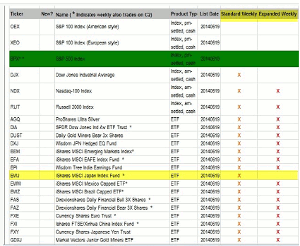Alan Ellman of TheBlueCollarInvestor.com shares the pros and cons of weekly options (or weeklys) for covered call writers along with the current tone of the market.
Weekly options (weeklys) are becoming an attractive choice for many covered call writers. These are options that expire every week rather than the more conventional monthly options. Weeklys are listed each week except that no new Weeklys are listed that would expire during the expiration week for regular options (the third Friday of each month), nor would they be listed if they would expire on the same date as a Quarterly option on the same underlying security. Other than SPX Weeklys (S&P 500 as the underlying security), closing times for Weekly options match the closing times for regular, non-weeklys on the same underlying stock or ETF.
On Nov 15, 2013, US options exchanges expanded the listing of weekly contracts from one expiration week to five straight weeks for a group of the most-actively traded options on stocks and exchange-traded funds. This known as the expanded weekly options program compared to the more well-known standard weekly option program. Most securities that appear on the BCI Premium Stock and ETF Reports are part of the expanded program. Both of our premium reports highlight which securities have weekly options associated with them.
The screenshot below shows a partial list of ETFs with weeklys as well as their participation in the standard and expanded programs:
ETFs with Weeklys
Note that EWJ is part of the standard weekly program but not of the expanded weekly program.
Advantages of Weeklys:
- Annualized returns can be higher.
- Can avoid exposure over weekends.
- Can generate greater premium as earnings report dates are approached and trade up to the week before earnings.
Disadvantages of Weeklys:
- The pool of stocks with Weeklys is much smaller than those with Monthlys.
- Management is much more time-consuming as "rolling" possibilities come up every week.
- Less time for exit strategy execution ("hitting a double," "mid-contract unwind," etc.).
- Quadruple the number and amount of commissions.
- Lower option liquidity.
- Wider bid-ask spreads leading to less favorable price executions.
There are many ways to make money in the stock market and using Weeklys may be appropriate for some investors. My personal preference is still Monthlys but I encourage those interested in Weeklys to paper-trade with them to see which timeframe leads to your greatest success.
Market tone:
In addition to the mostly bullish economic reports I am about to summarize, the fact that corporations can borrow money at ultra-low rates to buy back stock shares should continue to enhance earnings per share stats for our equities. Also, due to stronger 2nd quarter GDP growth, it is not unreasonable to expect a stellar upcoming earnings season:
- According to the Labor Department, 288,000 jobs were added in June, well above the 210,000 expected.
- Employment gains in April and May were revised upward by 29,000.
- The unemployment rate came in at 6.1% in June from 6.3% in May and from 7.5% from a year ago. This at a post-recession low.
- The number of unemployed dropped by 325,000 to 9.5 million, a decline of 2.3 million from a year ago.
- Factory orders fell by 0.5% in May, worse than the loss of 0.2% predicted by analysts, mainly due to a drop of 30.8% in the defense sector.
- There was a rise of 0.2% in non-defense orders in May.
- Construction spending rose by 0.1% in May, below expectations of + 0.5%.
- The ISM Manufacturing Index fell by 0.1 to 55.3 in June, but is still depicting expansion. The new orders index rose to 58.9, the best level this year.
- The ISM Non-Manufacturing Index (service sector) dipped from 56.3 to 56 in June, again, still reflecting an expanding economic environment.
- The US trade deficit declined 5.6% to $44.4 million in May.
For the holiday-shortened period last week, the S&P 500 (SPX) rose by 1.2%, for a year-to-date return of 8% including dividends.
By Alan Ellman of TheBlueCollarInvestor.com






















